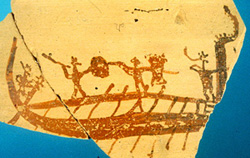 |
The Greek Age of Bronze
Ships |
 |
The Aegean has since prehistoric times been a sea that has united rather than separated the large or small islands. Between these islands, there were narrow sea passages and shallow gulfs, accessible by some primitive sailing means. Navigation in the Aegean, has been testified by the tools made of Melian obsidian which were found in Franchthi Cave in Hermionid (at the eastern coast of the Peloponnese, a distance of 80 nautical miles (approximately 150 kilometers) from Melos. Tools made of Melian obsidian also found on Crete (Knossos) and on Cyprus, substantiate the existence of sea routes in the Aegean from the Early till the Final Neolithic (6800-3200 BC).
They made a boat exclusively from papyrus, an aquatic plant which can be found near water areas of Greece ( as well as on the river Nile in Egypt). A similar boat was used until recently in Kerkyra. The "papyrela" could easily travel from Lavrion to Milos. Its crew would use kayak oars for navigation.
It has also been proven that men in the Greek prehistoric period could travel by sea using natural material offered by the domestic world of Greece and also using simple techniques such as the one of straw mats.
Evidence for ship construction in Aegean Bronze Age comprises 358 catalogue entries, these being 44 models, 173 linear representations (wall paintings, vase paintings, incisions) and 141 glyptic images. Crete provides over 55 per cent of the catalogue, the islands and the mainland less than 25 per cent each. Whereas the Minoan material is spread out over a timespan of a millenium (2500-1500 BC), the Cycladic documents are concentrated to the Early Cycladic II period, and to the site of Akrotiri in Late Minoan IA, while the mainland sees a scattering of inconsequential evidence down to the final phases of the Bronze Age, when a slight increase becomes manifest.
The typological classification of the Aegean ship is mainly based on the evolution of hull shapes as per Dr. Michael Wedde works (*0)
|
| The earliest hull-form to constitute a cluster is the shape illustrated by the Cycladic "frying pans" from Syros and the associated craft from Naxos, Palaikastro and Orchomenos. The hull is defined as low and flat, having one extremity rising and always equipped with a projection or "spur". Locomotive force is provided by numerous short strokes understood, due to their great number, rather as paddles than as oars. A mast or elements of rigging never appear. |
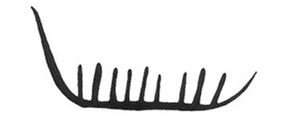 |
One of the very early representation of boat in the Aegean area is a graffito from Thessaly dated around 4500-3300 BC. Based on the general shape of the hull this boat could be identify as a precursor of the Type I |
| This clay model from Palaikastro Crete dated around 3000 BC is also one of the early representation of Type I Aegean ship. In this model the hull terminates at one in a lofty vertical or nearly vertical post, while the other, with no upright fixture at all, trails of into horizontal extension at the waterline. |
 |
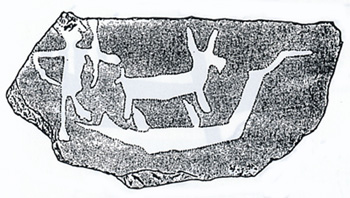 |
One of the earliest cycladic Type I ship representation is on a fragment of white marble from Naxos dated around 2500-2000 BC. It has a flat hull rising to bow with type 2 spur. Stern rises near vertically, surmounted by appendance departing obliquely aft to level out to horizontal at half its lenght. Two oblique projections from hull, understood as tholes. Above craft, animal (goat) and man holding weapons in both hands (right: knife?; left: stick? or bow?). |
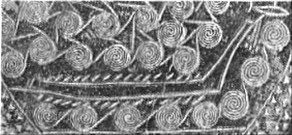 |
Another early large Aegean Type I ship is represented in this Cycladic terracotta "frying pan" from Syros dated around 2500-2000 BC. This multi-oared galley has a long vertical prow with a fish symbol mounted on top, perhaps acting as a wind vane to detect wind direction relative to the vessel. Also the cords or beams hanging bellow the fish symbol might conceivably act as some sort of wind catching element.
Note the waves shown as spirals, indicative of the orbital motion of real sea waves. |
| Type I ships with similar design and fish symbol on top of prow are well attested in several Cycladic representation dated around 2500-2000 BC. This type of ship was more likely the earliest wreck discovered near the island of Dokos. |
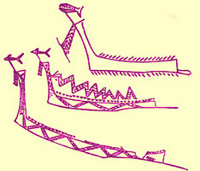 |
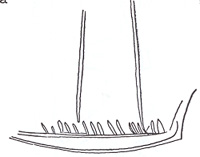 |
This Type I ship drawings dated EH II (about 2300 BC) were imitated as far inland as Orchomenos where the sketcher added a mast. The sixteen short vertical strokes above the sheer are best interpreted as paddles.
The Aegean were not the only trading ships at sea, of course, (*1) but they were among the most active and adventurous. |
| UNCLASTERED EARLY AEGEAN SHIPS
|
| A ship which show similarity with the Type I Cycladic design and with later types of hull design is one of the simbols of the still undeciphered disk from Phaistos dated 2000-1700 BC. This boat has a flat hull with raised, curving extremity to left, vertical post with slight projection at base to right. Post surmounted by horizontal element, from which hangs banner-like device. Just left of post, oblique line with ball terminal. |
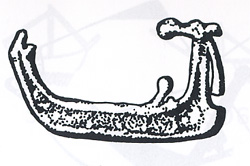 |
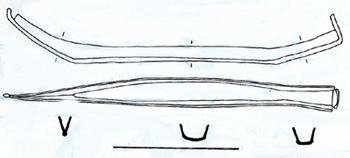 |
Lead boat model from Naxos dated about 2500-2000 BC which shows both similarity and differencies in the hull design and vertical prow respect to the contemporary typical Type I ships.
Each of the three models is constructed of three lenght of lead. The bow and keel are made from a rod of lead that was flattened by hammering the central two-thirds of its lenght to form a flat bottom. Two other flat strips form the sides of the hull. One extremity is raised and finishes in a vertical transom, while the other end is narrow and rised and rises at an angle. |
Clay model from Mochlos Crete date around 3000-2700 BC represent a small craft with bifid stem-projecting forefoot together with raised stem.This kind of ship distinguished by straight lines, angled ends, and a lofty prow seems to be a prototype for the later Greek warship and commercial ship.
Also in this case the general design of this ship shows both similarity and differencies with the contemporary Type I boats. |
 |
| A similar clay model dated EM II (about 2300 BC) is also attested from Mochlos. It has a flat hull with undifferentiated extremities rising to posts. Triangular cross-section and distinct axial curvature. |
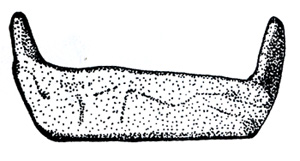 |
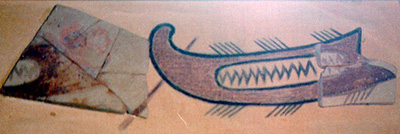 |
Another boat of a separate type from the contemporary Type I and Type II is represented in a scene restored from three small pottery fragments from Iolkos dated in the Middle Helladic period (about 2000-1700 BC). In this scene there are perhaps two ships and no people. The polychrome design shows a short vessel, thickly outlined, the reserved interior filled with zigzag pattern; there is a stout curved ram on the prow, and a steering oar. The polychromy is in the Cycladic tradition. |
| Another unclastered type of early Aegean ship is represented in this clay model of unknown provenance probably dated MM I (about 2000 BC). It is a flat-bottomed craft on four feet, placed one at bow and stern, two amidship. Vertical sides curving slightly inwards at top. Bow rises above gunwale level to point. Stern pointed plat. |
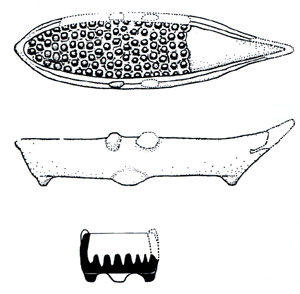 |
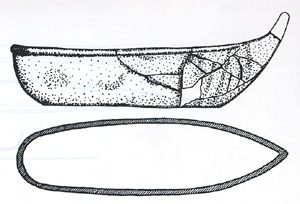 |
Alabaster model of unclastered boat from Agia Triada Crete dated LM I or LM II (about 1550-1500 BC). It has elongated hull with rounded stern and curved bow rising to point. |
A Lead model of what seems to be an unclastered type of early Aegean ship has been found in the Nuragic complex of Antigori di Sarroch Cagliari Sardinia. This specimen originally wrongly classified as a lead axe, has been found inside a small "Burial Cave" together human bones and Mycenaean pottery.
The general shape of this boat can be compared with Aegean ship representation from Festos dated TM III and Haghia Triada dated TM IIIC. Ship models in lead even if with different shape are also attested in the Cycladic island of Naxos |
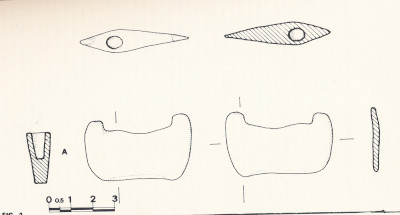 |
| TYPE II "Platanos Cluster"
|
Related to Syros craft are the earliest Minoan ships, know exclusively from sealstone. The aealiest members, dating to Early Minoan III, reproduce the general lines established by Type I with some differences in details: the stern rises to a height equal to a lesser percentage of the lenght overall, and a pronunced stempost appears occasionally to receive the forestays. The presence of a mast, and the use of oars rather than paddles, however, indicate that a significant increase in the beam has taken place.
Later members (the type disappears at the end of Middle Minoan II) show a more gradual transistion between keel and sternpost as well as greater variability in bow morphology: the angle between the spur and the post appears to equal either ninety, forty-five, or thirty-three degrees. The sternpost-terminal morphology exhibits three different, but related shapes, either a bi-a tri-, or a quadri-furcation. The bifurcation present on three members allow establishing a connection with the sternpost-terminal of Type III. |
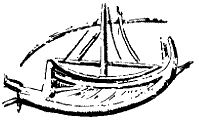 |
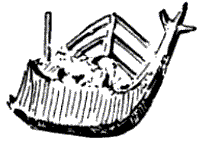 |
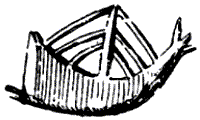 |
Minoan seal dated around 2000 BC with Type II boats representation. These ships also show an asymmetrical profile, a high stem at one end and low extension at the other. Even if the illustrations are very schematic, the repetition of certain details adds credibility to the depictions. For example the forked appearance of the lofty stem.
|
| Another Minoan seal from Paleocastros also dated around 2000 BC shows a Type II ship with high stem at one end and also high extension at the other. |
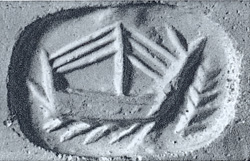 |
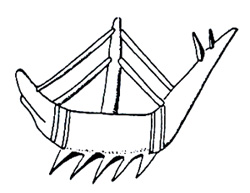 |
Type II ship representation on a seal from Mokhlos dated MM III. It shows curved hull with low bow comprising stempost and spur, raised sternpost terminated by trifurcation. |
| Another Minoan seal from Crete dated MM IIMM III shows a Type II ship with curved hull, spur and stempost, raised sternpost terminated by quadrifurcation. |
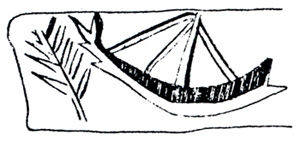 |
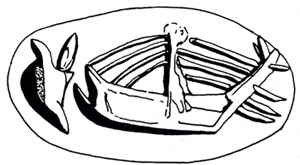 |
Type II ship representation on a seal from unknown provenance dated MM II. It has a flat hull, bow with stempost and spur, raised sternpost with quadrifurcation. |
| TYPE III "Kolonna Cluster"
|
The Type III boats show a decisive change in the manner the shipwrights designed the bow. From the angular lines with differentiation in the bow/stern height characteristic for both Type I and Type II, to the curved hull with equally high extremities of Type III, a significant step has been taken. To consider Type II and Type III part of a single evolutionary continuum requires common elements.These may be found in the treatment of the stern: the bifurcation seen on three members of Type II is universal to Type III wherever the stern has not been subject to foreshortening, or to damage. In such cases the inclusion in the cluster may be operated by the presence of a stempost-terminal in the shape of an arrow head, one of two alternatives, the other being a pointed bow, with or without bowsprit. The curvature of the hull may already be observed on several member of the Type II cluster, and the decreased angle between spur and stempost, if mirroring an actual state, tends towards the pointed bow of Type III.
A single representation on a clay nodule from Quartier Mu, Building V at Mallia may constitute something akin to a transitional shape. The hull is curved at both extremities. The stern is bifurcated in unusual, sweeping manner, whereas the bow appears to exhibit a spur-and -stempost morphology as seen on Type II craft. Although a steering-oar is lacking, sufficient indicators are present to assure a confident bow/stern identification. |
| This Minoan ship, represented on a seal stone from Pseira dated around 1800-1675 BC. has a beak shaped prow, high stern and single mast connected to the vessel by ropes. It show similarity with Type III boats. |
 |
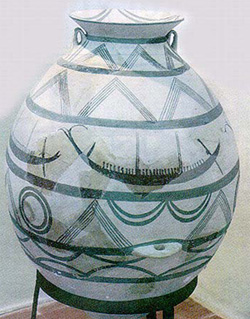 |
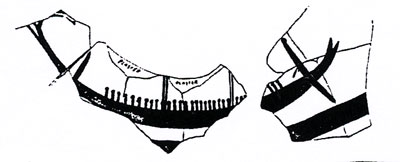 |
Type III ships are depicted on a vase from Kolonna Aigina dated MH II (about 1800-1650 BC). Because of the intensive commercial trade between the Aegean population and the Near Eastern Kingdoms some of the early Aegean ships show several similarity in general shape and design with the Egyptian ships of the same period. |
| A detail of one of the fragments from the Kolonna vase. Five stick figures, four crossed by oblique line, here interpreted as oars, disappearing into the hull, three long spears are also represented. |
 |
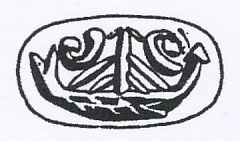 |
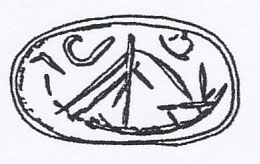 |
Type III ships from a seals of unknown provenance dated respectively MM I and MM IIA. These boats both show curved hull with arrow-headed stempost and sternpost with bifurcation. |
| Type III ships represented on a steatite three-side prism from Malia dated MM IIB. The ships have flat hull with arrow-headed stempost. Original state suggests sternpost with bifurcation. |
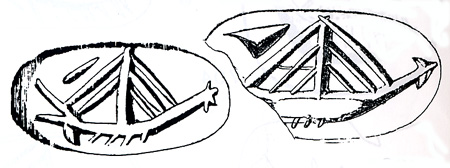 |
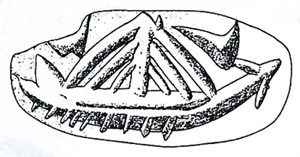 |
Type III ship representation from Malia dated MM IIB. It has a flat hull rising to oblique stempost with arrowhead, stern with bifurcation. Mast with three fore and backstays and nine oars. |
| Type III ship representation from Mokhlos found in LM I context but MM II in date. It has a flat hull with pointed extremities of unequal height. At stern line curving towards bow, probable bifurcation. |
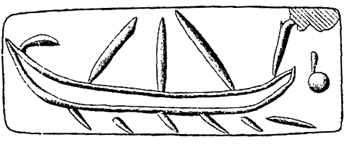 |
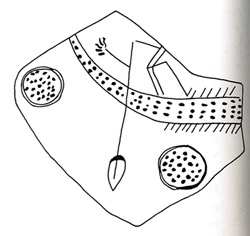 |
Possible Type III ship representation on a sherd fragment from Phylakopi Melos. The single steering oar is well represented. Rows of parallel lines above and bellow the hull apparently depict paddles. |
| TYPE IV "Akrotiri Cluster"
|
| The relationship of the Type III boat shape and the following Type IV , should be immediately clear: Type III is the forerunner to the crescent-shaped hull common to all the ships on the miniaturefresco, and to a further thirty representations of very uneven quality. The connection is further underscored by the Kolonna pithos, where the ships are equipped with an exuberant bowsprit and an awning, and where the passengers are shown seated along the lenght of the hull, possibly, though not necessarily, facing the bow. Type IV is far more scattered in space, and time. In spatial terms, there is a manifest bias towards Central and Eastern Crete, largely caused by the incidence sealstones. The Akrotiri data, on the other hand, composes a third of the cluster, but once exceptional and rich find has completelly changed the picture. The total population amounts to some fifty individuals but it is not inconceivable that the lack of resolution obscures differencies that could constitute grounds for dividing into smaller clusters. A further remark regarding Type IV is not without interest to the Minoan/Achaean confrontation: this hull-form constitutes the only shape in use in the Aegean from Middle Minoan III to Late Minoan III to whose existence the representation attest. |
| Several seals with various Type IV ship reprentations dated from 1800-1500 BC are attested from Crete. |
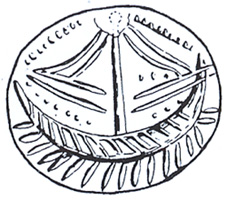 |
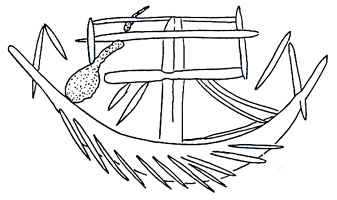 |
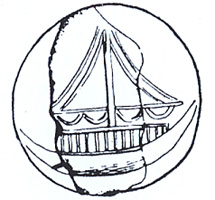 |
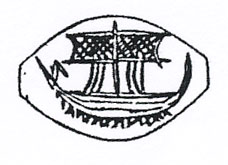 |
Type IV ship represented on a seal from unknown provenance (probably Knossos area) dated around 1600 BC. It has a curved hull with bird symbol, pointed sterpost and ten parallel oblique lines, probable oars. Mast with yard and boom, sail surface delimited vertically by cut lunette-like lines, cross-hatching. |
| Another similar ship is represented in this carnelian lentoid of unknown provenance dated LM IB (about 1570 BC). It has curved hull tapering to points at each extremity. Below hull, keelline, cutting across ten parallel oblique oarlines pointing to left. Slightly to left of amidship, mast, upper end split into two, with square-panelled sail on yard and boom. |
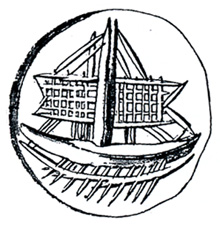 |
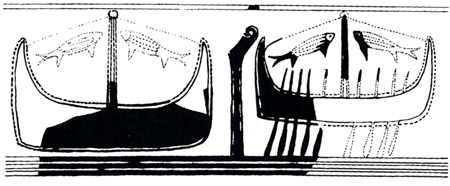 |
Type IV ship represented on a fragmentary pitharaki from Phaistos Palace dated LM III. are still visible fragment of flat hull with left extremity rising at right angle. Across hull, five oars thickening to blades at lower extremity, remains of stay. Above hull remains of mast. |
| A Late Helladic clay model of Type IV ship from Argos. It is a flat-bottomed craft with pointed extremities, and sides sloping outwards. Right extremity interpreted as bow. |
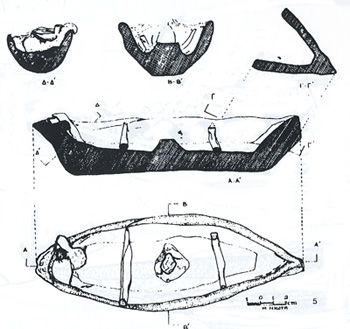 |
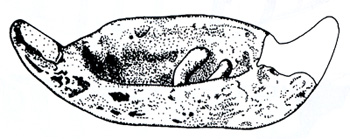 |
Another clay model of a Type IV ship from the Chambertomb 79 in Mycenae dated LH IIA-B (about 1370-1300). |
| A religious craft reproducing the Type IV shape is well represented on this stone amygdaloid of unknown provenance (probably in the region of Thebes) dated MM IIIB-LM I. It shows a crescent-shaped hull with pointed extremities equipped with bird symbols, two at bow, one at stern. |
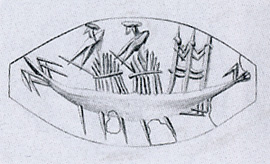 |
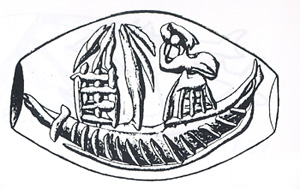 |
Another religious craft of Type IV from Makrygialos Crete dated LM I. It has a cresent-shaped hull with pointed extremities, right somewhat higher. 14 short parallel oblique to vertical strokes depicting ribs, square construction with three to four uprights, and four crossbar (ikrion). |
| Several Type IV ships are depicted in the famous fresco from Akrotiri in the Thera island dated around 1600 BC (*2). This images shows a small boat with 10 oars one sterring oar and a "skipper" or high rank passenger. |
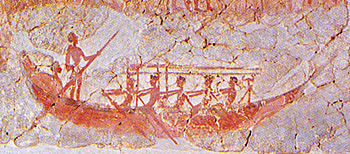 |
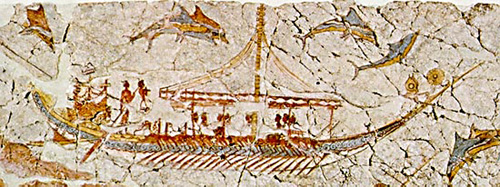 |
The Thera ships have one other interesting feature, namely the flat projection extending outwards from the stern just above the supposed waterline level. Interestingly, these illustrations seem to indicate the feature was added to the hull. The stem is long and slender with mysterious objects attached, similar to the Aegean "frying pan ship". If a storm wind came against the side of the vessel, the stem would catch the wind while the stern appendage drags in the water, turning the vessel around until the stern points into the waves. | .
| This other high decorated medium size ship shows the mast, the sail, two sterring oars, some passengers and the "ship captain" in the relevant cabin located on the back of the ship. The stern appendance was not present in the small and medium size ships it seems a prerogative of the large vessels. |
 |
 |
Another examples of the stern appendage is shown in this ship. The extended feature is clearly stern. This has been the subject of considerable scholarly debate both in terms of the relationship between the Thera ships and other contemporary ships known to exist on the same area. and of the function of the stern projection on the ships themselves. | .
| This other large size ship was probably compoused by a crew of 42 to 46 oars one sterring oar, the captain, two attendants of the captain and some passengers wearing either tunics or long robes. It is reasonable to suggest that they represent peple of higher status. Also in this representation the ship has the stern appendance, long stem with ornaments, central feature and captain's cabin. |
 |
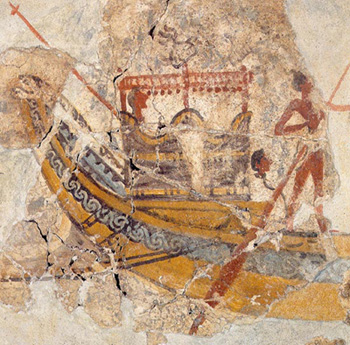 |
Closer detail of one of the Thera ships captain cabins. They consist of wooden poles wrapped by ox-hide sometimes decorated with religious simbols both Aegean and Egyptian. On top the cabin's central pole a strange object which seems to be a boar tusked helmet is placed. In the Thera ships these cabins were placed on the back of the ship, for this reason this features have been also identified as cabins for "VIP people" or elements with ceremonial significate. On Egyptian ships the captain's cabin was normally placed in the front so that he could have a good view ahead of him whereas the ceremonial cabin of the king or queen was placed in the middle. Some of these cabins have been also represented alone in the West house's room 4 fresco. They could allude to the marine festival which is depicted in the room 5 and with which the West house was connected. It is even possible to interpret them as emblems of the religious leader of the largest ship. These cabins were probably movable so they could be placed on or off the ships. This would suggest a ceremonial usage which is supported also by the evidence from seals where these cabins appears lone, possibly as emblems with some intrinsic importance. |
| De Cervin's reconstruction of the horizontal stern device on the Thera processional ships (1977: 151 fig.2 and 3): (A) the stern device with knee support; (B) plan view of the device; (C) hypothetical reconstruction of a ship being beached using ropes attached to the stern device. |
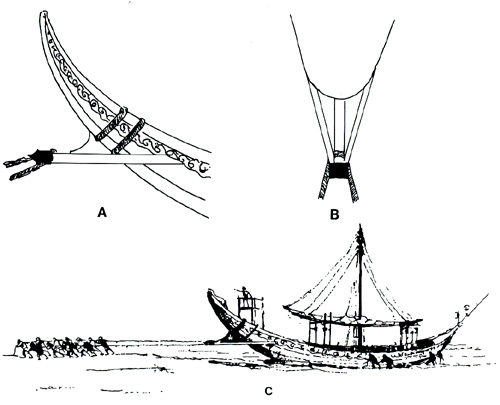 |
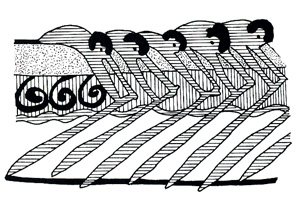 |
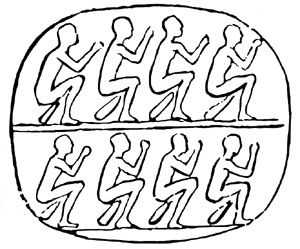 |
On the left image paddlers in the waterborne procession at Thera bending over to complete their stroke. On the right image paddlers/rowers on a fragmentary seal impression from Knossos dated MM III-LM I. |
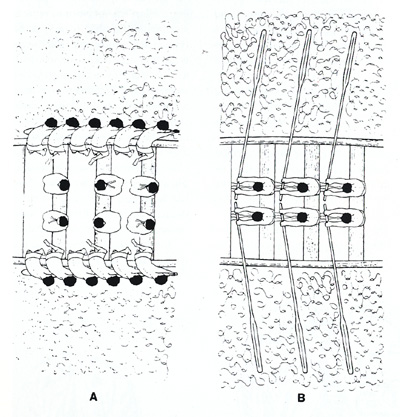 |
Tilley and Johnstone's (International Journal of Nautical Archaeology 1976: 287 fig. 1) reconstruction of the midship of a Thera ship being padded (A) and rowed (B) |
| The Akrotiri West house room 5 fresco is probably also representing the oldest sea battle so far attested. A conflict and naval engagement between aegean warrior and non-Aegean enemies (Lybian pirates?) seems to have taken place, and the outcome was victory for the Aegeans. The Aegean warriors arrived with their ships to protect the town and they have succeeded. We see the moment of victory when they are marching on the shore in triumph. |
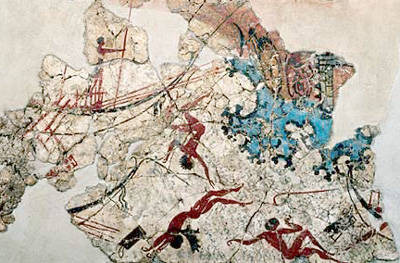 |
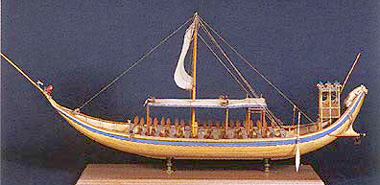 |
Based on the Thera fresco representations this very interesting and awesome model of a typical Type IV large ship of this period has been reconstructed. |
| Also based on the Thera fresco representations this very beautiful computer reconstruction of a Type IV Minoan ship |
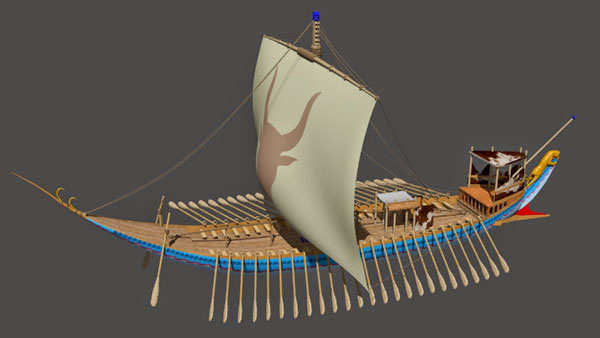 |
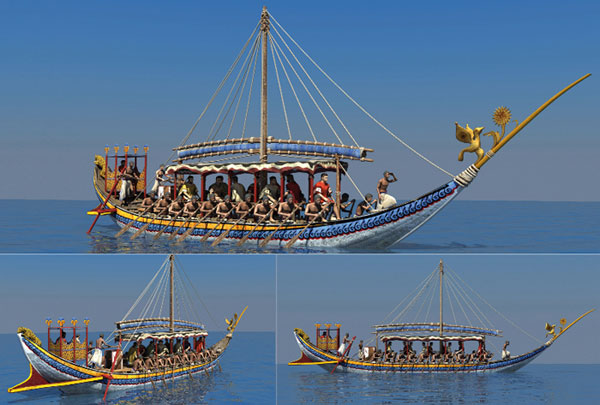 |
Another awesone computer reconstruction of a Type IV medium size Minoan ship always based on the Thera fresco representations |
| Based on the remaining fragments and on the rigging shown on the ships that struck sail, Spyridon Marinatos was able to reconstruct the sail and its rigging of the Minoan sailing ship of Type IV as represented by L. Morgan on his pubblication (1988: 124 fig. 71). The lines depicted are two pairs of lifts for both the yard and boom (A and B), halyards (C), braces (D), and sheets (E). |
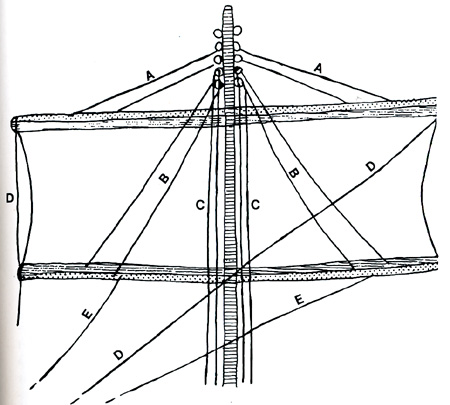 |
| The ship procession or race depicted in the West House was then, not a uniquely Theran festival. The custom continued in the Aegean long after Thera had sunk into the sea and after the autonomous Minoan culture had ceased to exist. This cultic race or procession was absorbed into various cultures and took place, presumably every spring, over millenia in the Aegean. |
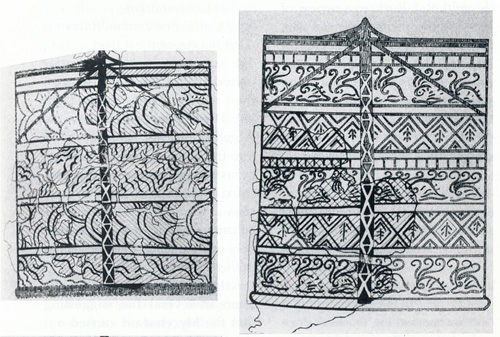 |
The boats' cabin (ikria) was also an important element of the cultic practice. It clearly appears only on those ships at Thera taking part in the procession/race and is also a main element depicted on the talismatic seals. The large ikria painted on the walls of Room 4 of the West House further attests to its cultic significance. Therefore, the possible appearance of ikria on a wall painting from Mycenae dated LH IIIB (see left images) supports the conclusion that the ikria-and with it the procession/race-continued into the Achaean cult. There are indeed other clues suggesting that the Achaeans carried out similar ship processions/race, like for instance the scene represented on the thirteenth-century amphoroid kraterfound at Enkomi (see bellow TYPE V "Skyros Cluster") |
| A Minoan shipwreck discoverd in the 2010 brings to the light 209 ceramic vessels, about 80 of which are nearly whole and clearly identifiable as types of amphoras and large jars that would have transported liquids, possibly wine and olive oil, though no residues remain. A handful of artifacts, including cooking pots, jugs, a few cups, and fishing weights, likely belonged to the ship's crew. Even though no wood from the ship survives, the archaeologists are convinced they belong to a wreck because they are an unusually large group of ceramic vessels that all date to the same period MM IIB, (1800-1700/1675 BC) and were all made on east Crete. Furthermore, the pottery that was still in place was found upside down, which seems to indicate the ship completely capsized and wound up with the hull uppermost and the cargo down. The ceramics broaden into a roughly oval-shaped concentration that extends over an area 50 by 65 feet, from which it is possible to estimate -by the distribution of objects- the ship to have been between 32 and 50 feet long. |
| RELATED WITH TYPE IV "TALISMANIC" SHIPS
|
| From Crete is also this amygdaloid seal dated around 1600-1500 BC with a representation of a "Talismanic" boat image which is related with the type IV ships even if with some differencies are present in the forked lofty stem, mast and sails. | .
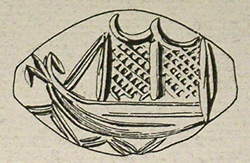 |
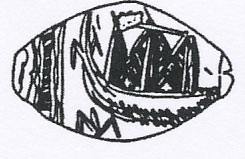 |
Same kind of "Talismanic" ship related with the Type IV, is also represented on this seal of unknown provenance dated MM III-LM I. It shows curved hull with pointed extremity and bird symbol and cabin-like structure. | .
| Related to Type IV "Talismanic" ship reprentation dated from 1800-1500 BC from Crete. It has a curved hull with pointed extremity and bird symbol. Cabin-like construction at what appears to be amidship. |
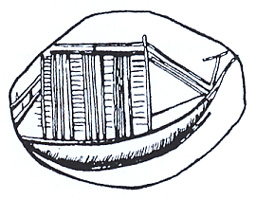 |
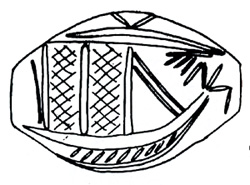 |
Similar "Talismanic" ship related with the Type IV, is also represented on this seal from Malia-Khrysolakkos dated LM I. | .
| Another typical related to Type IV "Talismanic" ship reprentation from Smari Crete dated LM IB. It has a stright thick hull with pointed extremity and bird symbol. Keelline joined to hull by nine oar-lines. |
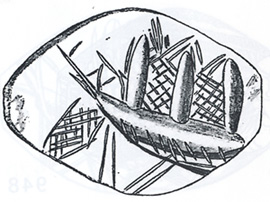 |
| UNCLASTERED REPRESENTATIONS RELATED WITH TYPE IV SHIPS
|
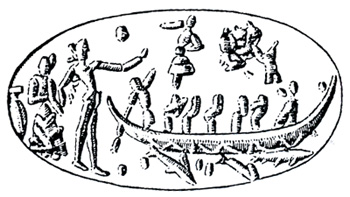 |
Unclastered boat representation on a gold ring found near Kandia probably from Harbour Town of Knossos dated about 1550 BC. It has flat hull with curving extremities, right end somewhat higher Zig-zag line along hull.Globule at tip of post, perhaps part of bifurcation. |
| What appears to be a papyrus craft with a steering-oar and three oars is represented in this gold ring from Tiryns dated around 1500 BC. This unclastered type of Achaean ship shows some similitude with the Type IV Minoan ships represented in the fresco from Thera also with sterring oar and two passengers in the central cab. |
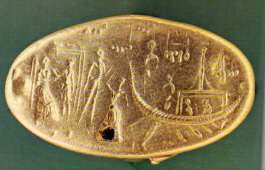 |
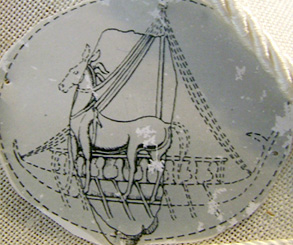 |
There is another interesting seal from Knossos dated more likely in the final phase of LM III (about 1200 BC). This seal, probably used as a warranty mark for the traded goods, shows a huge Achaean style horse placed over a single mast medium size possible Type IV ship with oarsmen. |
| Fragment of marble rhyton from Epidauros found in disturbed layers with EH-LH ceramics and idols. At lower right a ship cabin is represented. At base of square, protome dolphin rears up. To left shore line with marching men. Lower left at least two men behind body-shields and long baton or spear. In this case it is not possible to identify the ship even if a Type IV is very likely. |
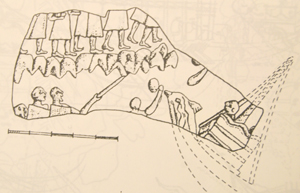 |
Another possible Type IV ship is represented in a fresco fragment, dated between the LH IIB and LH IIIA1, from Iklaina settlement located near Pylos.
The arms of the oarsmenare outstretched (resembling those of the Theran boat), indicating that they
are at the beginning of the stroke. The Iklaina ship is similar in style to the Achaean representations
from Aegina and Argos, especially insofar as the shape of the hull is concerned. On the other hand, there are also notable affinities with ship representations from Akrotiri and Ayia Irini. |
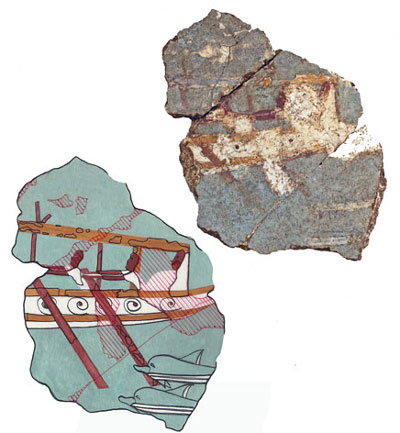 |
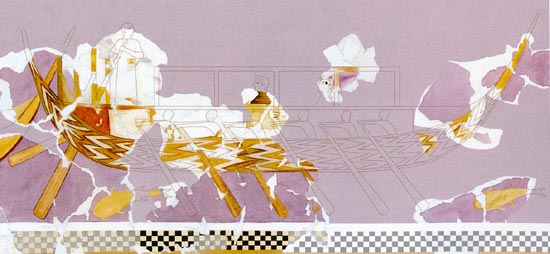 |
Other possible Type IV ships are also represented in a naval scene from the fresco dated LH IIIA in Hall 64 of the "Nestor" palace in Pylos. One of the ship shows a complex vertival zigzag pattern on the entire hull. This same geometric pattern in simpler form (i.e., a single horizontal zigzag line) is often found on the hulls of ships represented on Early Cycladic "frying pans" and in the miniature frieze from Kea |
| In the same fresco other two similar ships are represented in this case without any decoration on hulls. The line at the stern was obviously meant to continue toward the bow and it may represent a gangway connecting it to a stern. Such a gangway could also have served to protect the heads of the rowers, as is the case in a representation from Kynos. The ships also preserve evidence for wooden superstructures set amidships, probably cabins with divided compartments.. |
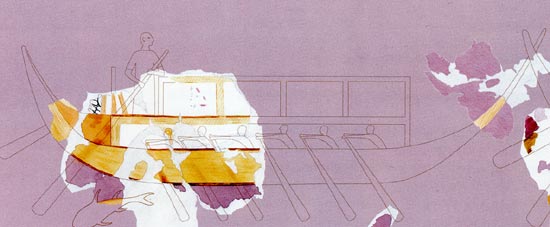 |
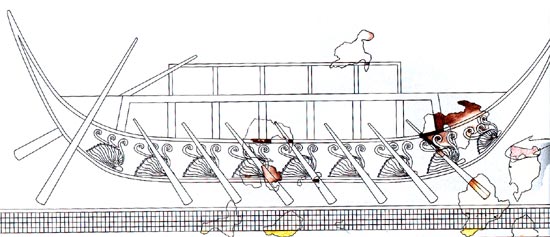 |
A further Type IV ship is also represented in the Hall 64. This ship shows an unusual hull decoration with a row of Argonauts (usually called nautili). This motif seem to be favorite at the Palace of Nestor, one used mainly for decorative frieze but also in large-scale compositions. This motif, has not previously been attested as decoration on a ship, although animals and fish were used on the Theran ships, and dolphins are seen on examples from Kea |
In the upper figure fresco fragments with part of a beam and rigging from the Room 31 in the Pylos palace.
In the lower figure fresco fragments with rigging and possibly part of a furled sail from area MZ, slope southwest of Hall 64 also in the Pylos palace. |
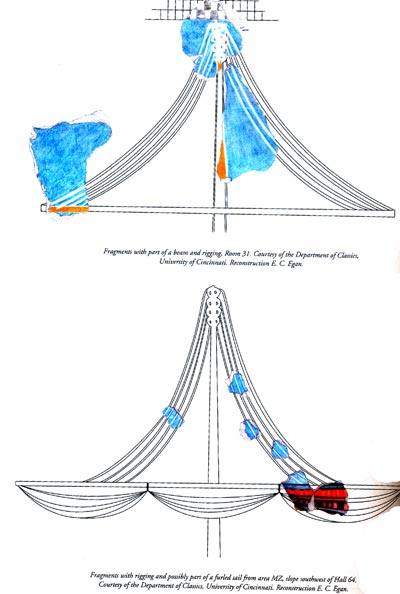 |
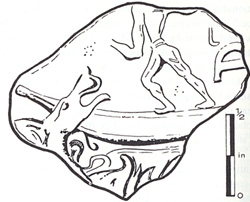 |
On this clay seal impression from Knossos dated around 1600 BC a fearful sea creature with a doglike head, attacking a small ship is depicted. This "sea-monster" has been interpreted by Sir Arthur Evans as a prototype of Scylla, and though her monster heads were multiplied and modified by later Mycenaean tradition.
Also in this case it is not possible to identify the type of the ship which could be also a "cult" or "ritual" boat. |
| A very interesting "cult" or "ritual" ship is represented on this ring from Crete named "Ring of Minos" dated around 1500 BC (*3). In this ring a priestess steering a shrineladen boat acrooss a bay is depicted. The small boat seems to be decorated with a sea-horse head representation and two cerimonial shrine or altars with sacral horns seem apparently built or transported on the afterdeck. This representation offer some additional support for the idea of a sea-shore cult involving both fixed shrines built on the land and portable shrines ferried coastwise by priestesses. |
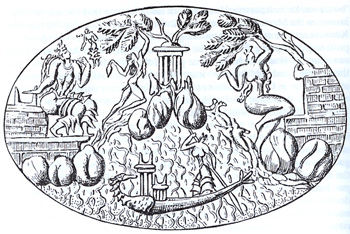 |
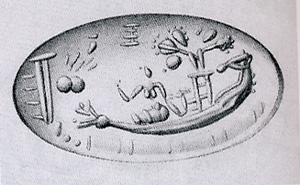 |
A similar scene with a "cult" boat is also represented in this other gold signet ring from the port of Mochlos. |
| Cul boat representation on clay seal from Agia Triada dated LM I. It seems to be a vessel in shape of bird lying on its back, head with beak, eye and crest, tail with three feathers, wing feathers discernible along flank. |
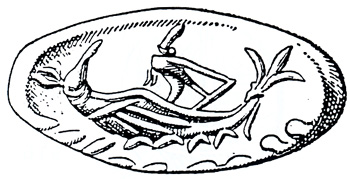 |
When a ship appears that can be termed as Achaean it does so in two distinct hull-forms incapable of being temporally serialized, Type V and Type VI. The Type V is characterized by a straight-keeled hull with a raised setrnpost, either straight or gracefully swung back in over the rear and exhibiting a bifurcation. The stempost is vertical, and terminated by an animal- or a bird-head. The absence of a spur, present in the Type VI, constitutes the main reason for recognizing two different clusters.
Due to the played in the Levant by the animal-or bird-headed stempost (and the case of Sea People craft from Medinet Habu, an identical sternpost) during the out-going Late Bronze Age, and the appearance of similar stempost terminals in later periods, the presence , in the Aegean data, of a hull exhibiting such traits, not combined with a spur, is of particular interest to the history of East Mediterranean ship architecture.
|
 |
| This amphoroid krater fragments from Enkomi Cyprus dated around LH IIIB (about 1350 BC) show elaborate representation of Type V ship and two classes of men: the huge warriors with spotted robes, helmets, and swords, who stand on the deck or the shore, and the little nude men who toil below the decks. This is the first full naval scene in the history of Achaean pictorial painting (as opposed the above shown isolate Middle Cycladic or Helladic pictures of ships, or the naval fresco from Thera). The scene seems almost the same on each side: the ship, with three or four lilies on the stem, a mast with stacked rigging rings or deadeyes, and a bird prow, support two large figures on the upper deck, facing each other across the mast, and four small figures on the lower deck, facing each other in pairs across the mast-step. It is clearly a military scene, not a pure commercial venture, nor a festival voyage as on Thera, and it fits well with the recorded Sea Peoples raids of the thirteenth century, a prototype for ship-raiding scenes in Homer. |
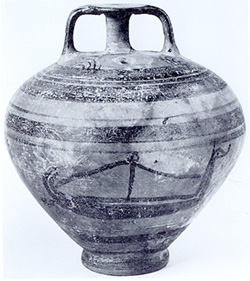 |
A stirrup jar from Skyros dated LH IIIC has a long bird-headed Type V ship. It is drawn with a long narrow hull made of two lines that angle up as a triangular-bladed steering oar obliquely across it, and the stern curves up and over into a double tail. The mast is centered and surmounted with a ring or halyard deadeye; below it two tautened stays run to stern and prow. No sail is set. |
| Very interesting bird-boat motif painted on a krater sherd from Tiryns dated LH IIIC. This Type V boat with two headed bird simbol shows closer similarity with the Sea Peoples's ones represented on the Medinet Habu relief. |
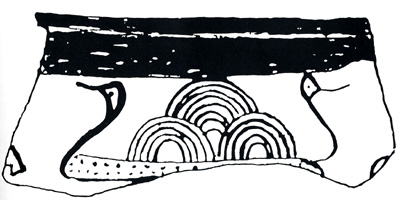 |
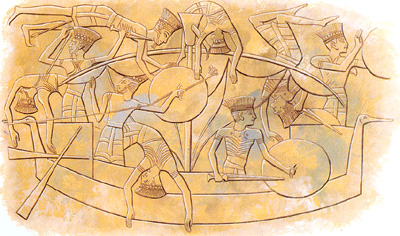 |
If there is no doubt between the similarity of the ship represented in the Tiryns krater sherd and the ones of the Sea Peoples as shown on the Medinet Habu relief, how far the above mentioned ship from Skyros jar is influenced by the bird-headed ship of the Sea Peoples, or by "Philistine" contacts in the twelfth century is not clear; Skyros was a natural home for pirates and sea rovers, who would have seen innovative ship in the Levant and across the Aegean. |
| The above mentioned representation of Aegean double-headed bird-boats show closer and very interesting similarity with some ships models or representations of the Late Bronze Age found the Central Europe as these embossed Urnfield ornaments from Slovakia and Pomerania. |
 |
| The excavation in Pyrgos Livanates in East Locris and in all likelihood the site of Kynos, the home of Ajax Oileus in the Iliad, has disclosed a major LH IIIC site with an extensive building complex. The pottery produced at the site includes vessels with striking depictions of Type V ships, warriors and sea battles. The ships depicted appear to include both wide-bodied merchantmen and narrow warships. A terracotta ship model recovered in the excavation may originally have contained fifty oars, matching the description of ships in Homer as well as the Jason's mythical ship Argo. A depiction of a similar oared galley appears on an angular alabastron dated around 1100 BC found in a reused LH IIA tholos tomb at Tragana near the palace of Pylos. |
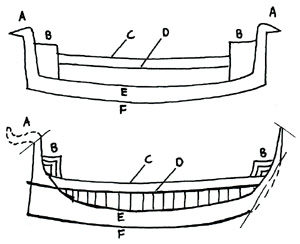 |
The construction details comparison between the Sea Peoples’s ship represented in the Medinet Habu temple and the Type V Achaean one from Kynos show closer common elements like the bird headed prow (A), the two platforms (B), the bulwark protecting rowers (C-D), the wooden hull (E-F) were the F representing the line of the keel or keel-plank and the E the caprail.
The above shown ship iconography confirms the significant interconnection between Achaeans and Sea Peoples, documented so well in other aspects of material cultures (see also the page dedicated to the Sea Peoples)
|
| A Narrow medium size Type V ship, warriors and steering oar involved in a sea battle is also represented in this other pottery fragment from Kynos dated LH IIIC. The ship has an high indented stem and a long stern. These warships were shallow-draught vessels and could be beached in sandy bay. Homer describes the Achaean ships as being dragged up onto the beach and held upright with props (*4) |
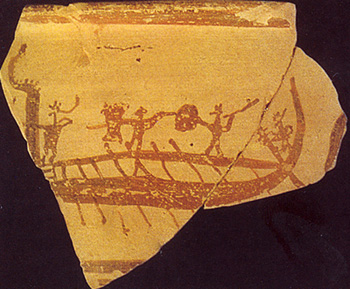 |
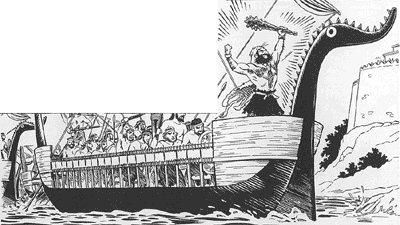 |
A beautiful representation of a Type V Achaean warship has been made by Eric Shanower in the number 3 of his awesome mithologically and archaeologically based comic serie AGE OF BRONZE THE STORY OF THE TROJAN WAR. The scene and the ship, more likely based on the above shown pottery fragment from Kynos, is related to the mithical first Achaean attach to Troy lead by Herakles and his followers. |
| Terracotta model of a Type V ship's bow fragment from Pyrgos Livanaton dated LH IIIC. |
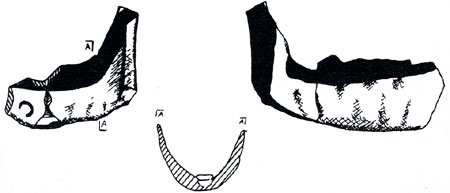 |
 |
Possible Aegean-style ship of Type V engraved on a seal from Beit Shemesh . Philistine wares are prevalent at Beit Shemesh . Therefore, it seems probable that the prototype of the ship engraved on the seal was Philistine |
| TYPE VI "Tragana Cluster"
|
| With the continuation of the keel into a spur projecting beyound the straight sterpost, the Achaeans created a new hull-form, best represented by the vessels on the pyxis from Tragana and the larnax from Gazi. The keel is flat, the sterpost generally straight with a slight curvature at the junction; essentially, then, the shape established by Skyros craft- both types share the loose-footed sail common at the end of the Late Bronze Age and not attested for Minoan ship- with the addition of the spur. This must have amounted to a complete redessigning of the bow, a task which, taking into account the conservatism prevalent among shipbuilders, surely was undertaken with a definite purpose in mind, in view of a net gain in performance. A speculative reason behind this development may be sought in the ability to beach at speed without damage the bow. Any suggestion of employing the spur as a ram is groundless: in every case the stempost extends beyond the spur, implying potential damage to the ramming ship.
|
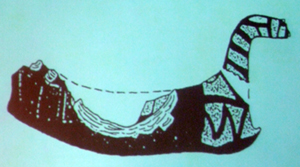 |
Very interesting developed clay of a Type VI ship model from Tiryns dated LH IIIB (about 1300 BC). |
| Other teccacotta model of a Type VI ship dated LH IIIC (about 1200 BC). |
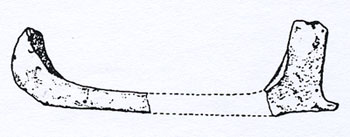 |
 |
A typic Type VI Late Achaean ship is represented on a pyxis from the Tragana tholos tomb near Pylos dated LH IIIC (about 1200 BC). It is a long lean ship with a low gunwale, equipped with a ram as on the Middle Helladic Iolkos fragments but more swift-looking and narrow. It is probably meant to represent a warship or one suited to pirate raids, not a merchantman. The mast is centered, with an oval sail, whose form is more influenced by the filled concentric arcs on the ornamental panels of the pyxis than by marine facts. |
| An interesting and reasonable reconstruction of the Achaean Type VI ship depicted in the Tragana pyxis has been made by Peter Connoly (*5). This heavy warship had 50 oars and it is shown with both sails and oars but more likely these would not be used at the same time being the sails only used when the wind was in the right direction. The latticework panels popular in the period are used for the steering platform in the stern, underneath which the steering oar and tiller project on the diagonal, and for the lookout platform or windscreen in the high stem. In the Iliad the Achaean's ship are described as black (*6), probably because their keels were tarred. Of course in the upper parts they could have been decorated in any colour, for instance Odysseus refers to crimson-painted ship (*7). |
 |
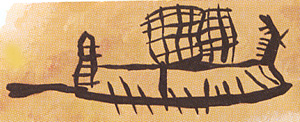 |
The Type VI ship on the stirrup jar from Asine dated LH IIIC is miniature and poorly drawn. Probably it is sailing right, with an incurved bow and a slight ram, a fringed curved screen or relic of the fish standard on the prow, a centered sail, square and crosshatched, with the mast off-center at the left corner, eleven oars, a tall laddered steering platform, and a steering oar lying almost level in the water. |
| Another Type VI war ship is depicted in this LH IIIC pottery fragment from Kynos. Although it is only partially preserved, we can recognise an oar-propelled galley with low angular hull, a rather high stem or stern and many oars. |
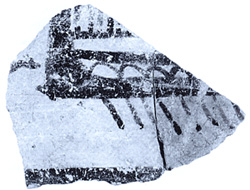 |
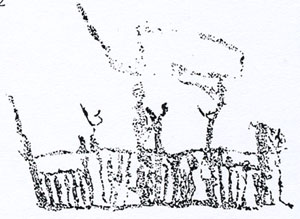 |
A Type VI ship seems to be also repesented on this graffito from Dramesi dated LH IIIB |
| A Type VI ship it is very likely represented onthis cup sherd from Phaistos dated LM IIIC |
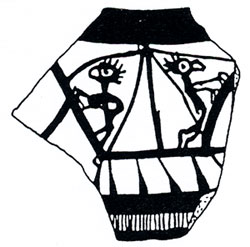 |
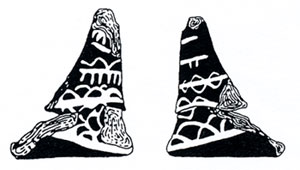 |
Bow fragment of a probably Type VI ship from Athens dated LH IIIC. This model is displayed at the Kropolis museum.dated LM IIIC |
| A Type VI large Achaean warship is very likely also represented in this pottery fragment from Kastanas dated LH IIIC The drawing is very schematic but it is possible to identify one of the platforms normally located in the high stem or in the stern area, the sail and the oars. In the Iliad is mentioned that the rowers were numbed in leg and arm by the toil of smiting the sea-water with their blades of polished pine (*8). |
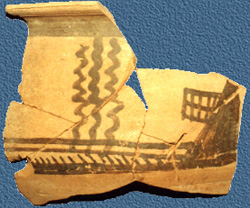 |
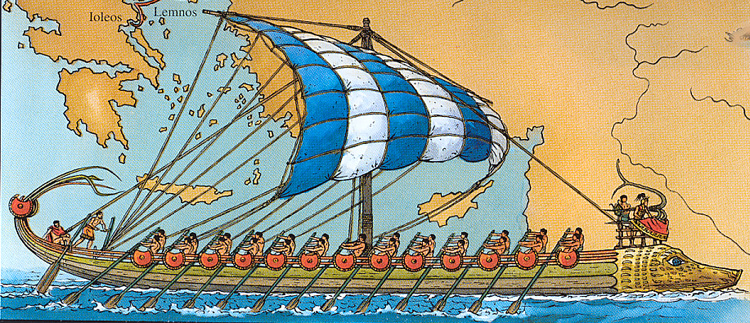 |
|
An interesting reprentation of the mithical Jason's ship Argo has been made by Marc Henniquiau and Jacques Martin (*9). According to ancient Greek mythology Aeson was the rightful king of Iolcos, but his brother Pelias usurped the throne. It was Pelias who sent Aeson's son Jason and his Argonauts to look for the Golden Fleece. The ship Argo set sail from Iolcos with a crew of fifty demigods and princes under Jason's leadership in the 13th century B.C. Jason assembled a great group of heroes known as the Argonauts. They included Heracles, Philoctetes, Peleus, Telamon, Nauplios, Argus, Orpheus, Castor and Polydeuces, Atalanta and Euphemus. Their mission was to reach Colchis in Aea at the eastern seaboard of the Black Sea and reclaim and bring back the Golden Fleece, a symbol of the opening of new trade routes. Along with the Golden Fleece Jason brought a wife, the sorceress Medea, king Aeetes' daughter, granddaughter of the Sun, niece of Circe, princess of Aea, and later queen of Iolkos, Korinth and Aea, and also slayer of her brother Apsyrtus and her two sons from Jason, a tragic figure whose trials and tribulations were artfully dramatized in the much staged Euripides' Medea. The place of ancient Iolcos is believed to be located in modern-day nearby Dimini, where a Mycenaean palace was recently excavated. |
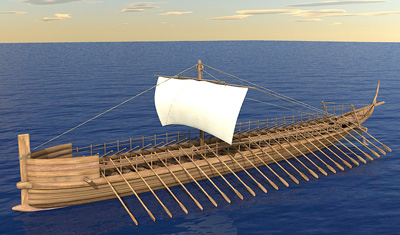 |
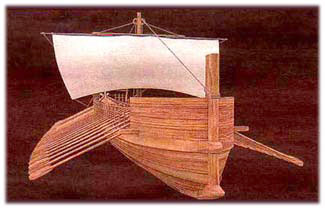 |
The boat Argo was constructed with the help of Goddess Athena. The shipbuilder was Argus, and so the ship was named after him, Argus meaning swift. The wood came from the pine trees of Mountain Pelion, and from the talking oak trees of Dodone, and as such the boat was endowed with the gift of speech.
The Municipality of Volos, in conjunction with the local Municipal Tourist Bureau and the research team of "Navdomos", reconstructed the myth and the ambitious project, which took years of painstaking enquiry and relevant studies, at the end materialized, with the newly built replica of the mythical Argo and its launching on September 17, 2006, in the presence of Prime Minister Costas Karamanlis.
The building of the ship, with Bronze Age tools to the specifications of a Mycenaean-era vessel, took place at the shipbuilding yard in Pefkakia, near Volos. The 28.5 meter long and 4 meter wide vessel have on 50 oarsmen. The 50 rowers are citizens from all the member-states of the European Union. Argo travels to the ancient Colchis, present-day Georgia, symbolically looking for the "Golden Fleece" of our times.
|
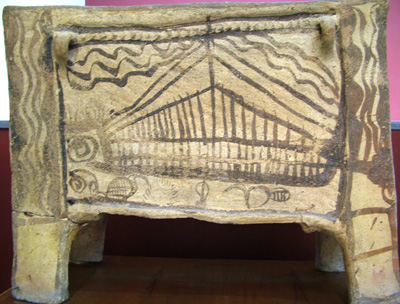 |
A similar Type VI large ship with large sail and several oars is represented in this larnax from Crete dated around XII century BC. |
| A possible Type VI large ship could be also the one visible in few fresco fragments from the Orchomenos Palace dated LH IIIB |
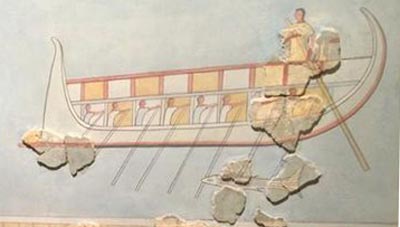 |
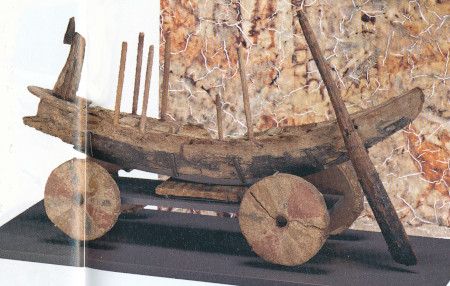 |
A possible Aegean Type VI ship is also represented in a Egyptian wooden model fromm a tomb at Gurob dated between 13th-12th century BC. |
| Hypothetical analysis of Type III-IV, V, and VI warfare capability performed by Dr. Michael Wedde (*10) |
| UNCLASTERED LATE AEGEAN SHIPS
|
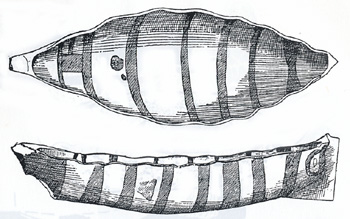 |
A beautiful clay model of unclastered type of Late Aegean ship from Phylakopi of uncertain datation (LCyc I-II to LH III). It has an almond-shaped hull with gunwale forming wavy line, stern outside painted black. Eye and cutwater at bow. |
| Clay model of unclastered ship from Asine probably dated LH IIIC. Half of hull extant, sweeping stern and bow-figure being modern restorations. |
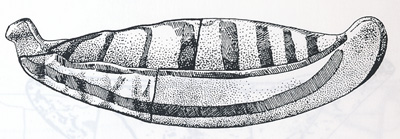 |
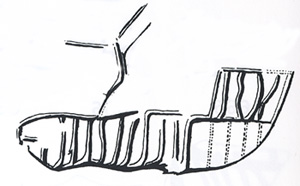 |
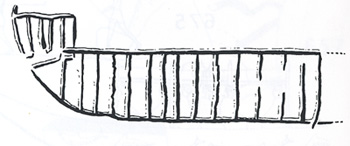 |
Unclastered late Aegean ships represented in the stela from Dramesi dated LH III. These boats show flat hull with keel and gunwhale lines joined by 15 vertical parallel strokes. |
| Proto-Geometric representation of ships on a vase from Heraklion dated 1050-900 BC. The ships still show some characteristics of Late Bronze Age vessels and similarity to those from Sea Peoples represented in Medinet Habu
|
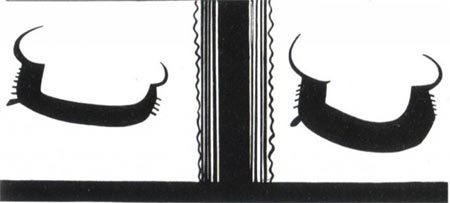 |
| A very unique and interesting representation of ship is present on this table from Ithaca. This Late Helladic clay table of uncertain dating has been found by the Archaeologists Thanasis Papadopoulos and Litsa Kontorli in the same area of a recentelly discovered Achaean palace. The clay table is very likely repesenting an episode from the Odyssey-the ship with Odysseus bound to the mast- with monster-like motifs on either side and markings which are probably Linear B script like the sigh AB09 "SE".
|
| UNCLASTERED FRAGMENTARY REPRESENTATIONS OF GALLEY
|
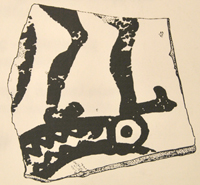 |
Achaean sherd dated LH IIIC1b (about 1200-1190 BC) from Ashkelon Israel with lower legs of human figure standing on bird's head curved line of a possible ship's sterm. |
| On this LH IIIC ship representation from Kynos we can see the feet of a warrior standing on a ship deck and underneath a waid bulwark runs along the side of the ship. Its decoration shows a common motif used to fill decorative bands on Achaean vases. Below the bulwark the low hull of the ship can be seen and eleven oars are depicted, extendind from above the gunwale down below the keel. |
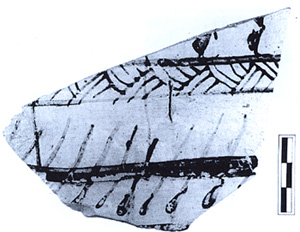 |
| On another fragment from Kynos dated LH IIIC a part of undecked rowing-ship is pictured. It seems that both type of war-ships, decked and undecked, existed at the same time and were used to transport troops. |
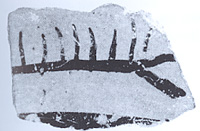 |
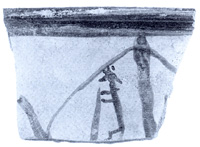 |
A small sailing ship, or rather a sailingboat is depicted in this fragment of a krater from Kynos also dated LH IIIC. Preserved on the sherd are the mast, a backstay and a forestay and one of the boat extremities that rise well above the gunwale or the deck (if there was one). The standing figure between mast and stay facing this end perhaps suggests that we are dealing with a stern. |
| On these two pottery fragments, perhaps belong to the same krater, warriors with helmets and rectangular shields on board of war-ships are picture. In the left piece we distinguish the mast of a ship, at the top of which two brails hang from a double ring. The horizontal line under the rings should be the yard of the sail, and the hanging festoon-like semicircles obviously represent the brailed-up sail. In the right piece a warrior seems to be standing below the construction behind him. This construction could be a rail or a bulwark, than the warrior is probably standing in the hull of an undecked ship. |
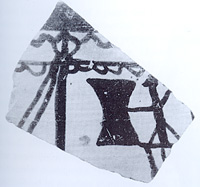 |
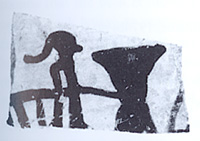 |
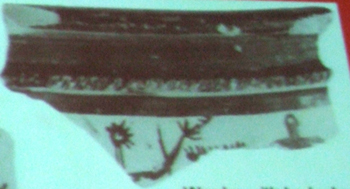 |
Warriors with hedgehog helmets behind a ship's prow are depicted in this fragment of a krater from Kynos also dated LH IIIC. |
| A warrior with hedgehog helmet and possible banded cuirass on a ship is also attested on this krater fragment from Kynos also dated LH IIIC |
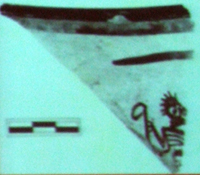 |
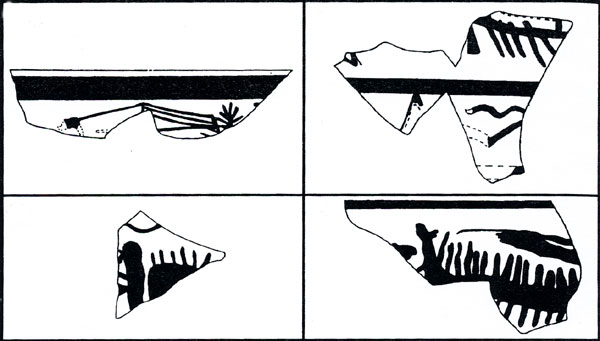 |
Fragments of sherd with ships representataion from Phylakopi dated LH IIIC |
| Ship's stern represented on a krater sherd fragment from Kalapodi dated LH IIIC |
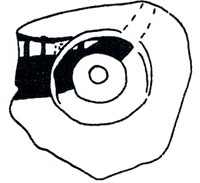 |
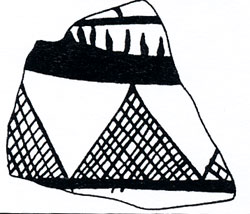 |
Ship's hull section represented on a krater sherd fragment from Athens dated LH IIIC. This specimen is displayed in the Akropolis museum. |
| Terracotta ships model fragments representing bow and stempost from Pyrgos Livanaton dated LH IIIC |
 |
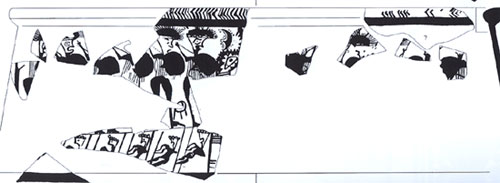 |
Naval battle is also depicted in this krater from Bademgedigi Tepe in the west Anataolia dated LH IIIC. Sea battles are clearly one of the most popular theme in the final phase of the Late Heladic period and they are not only a Greek mainland phenomenon, but also appear on the islands and the coast of Asia Minor. They are probably evidence of a new kind of warfare. The fact that similar scenes were found across the Aegean could suggest that war at sea was more common than before. |
| A detail of the same krater fragment from the Anatolian site of Bademgedigi Tepe shows the rowers in the bellow deck. The more fully preserved rower on the right shows that the rowers have both hands on the oars which rise up to the deck above. |
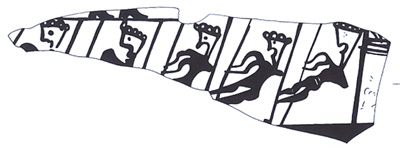 |
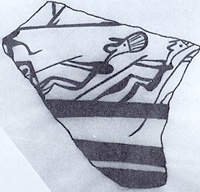 |
Two oarsmen are well attested in this pottery fragment from Kos Seragio dated around 1200-1100 BC. The fragment shows the lower deck of a ship being rowd right by two sailors in baggy turbans. The ship is shown in cross section, as on the Enkomy vase. |
| Men on oared ship are depicted in this sherd fragment from Xeropolis Lefkandi also dated LH IIIC. |
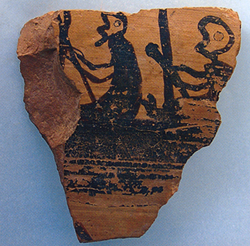 |
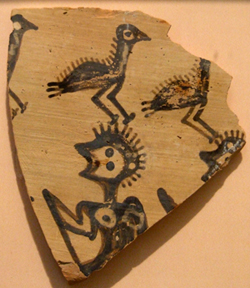 |
Two warriors rowing are also well depicted on this pottery fragment from Voudeni dated around 1200-1100 BC. The warriors seem to be equipped with decorated or embossed helmet and corselet. |
| Men on oared ship are also depicted in this sherd fragment from Greecev mainland also dated LH IIIC. |
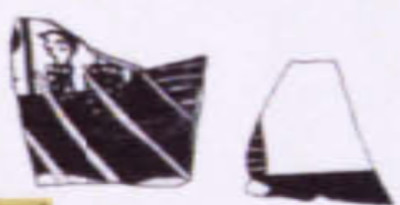 |
| Some boat representations in stone stele graffito and in ship-shaped rhyta, are known from Cyprus. The graffito, although very schematic, may be assigned to Type VI with confidence: the curving stern, the bow projection and birdheaded stempost. Three of the rhyta are devoid of bow projection and should be assigned to Type V, but it should be noted that the inward lean of the post is reminescent of the Achaean ship from Asine. The fourth ship-shaped rhyta exhibits the same inward-leaning stempost, but has a projection.
|
| Very schematic ships, probably of Type VI, representation from Late Cypriote stone stele dated 1200-1100 BC
|
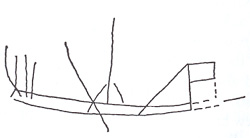 |
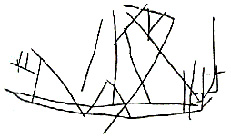 |
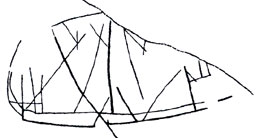 |
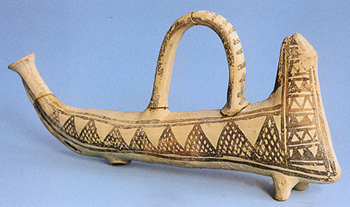 |
Vase of Proto-White painted ware, in the form of a warship probably of Type V from Lapithos (Tomb 74) Cyprus date around 1150-1050 BC. The surface is covered with painted geometric patterns. Long and swift warships were no doubt used to bring the Achaean immigrants to Cyprus and other places where they settled at the end of the Late Bronze Age. |
| Similar askoi of Proto-White painted ware in the form of warship, probably of Type VI always from Cyprus dated around 1150-1050 BC. Also in this case the surface is coverd with painted geometric patterns. Whether the newcomers are called raiders or refugees seeking to settle in a new home in Cyprus, it is clear at any rate that those who came from the Aegean must have come to the island in organized groups, with aristocratic leaders who could afford to arrange their transport in warships during a period when piracy made traveling in the Mediterranean difficult. |
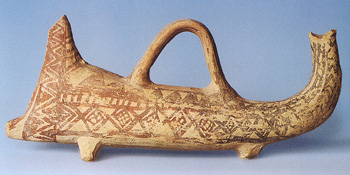 |
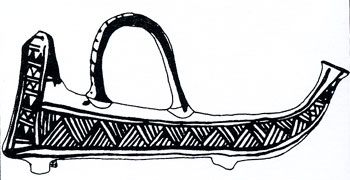 |
Vase of Proto-White painted ware, in the form of a warship, probably of Type V from Lapithos Cyprus date around 1150-1050 BC. Also in this model the surface is covered with painted geometric patterns. |
| Vase of Proto-White painted ware, in the form of a warship probably of Type V from Lapithos Cyprus date around 1150-1050 BC. In this case the bird-head stempost is still preserved. |
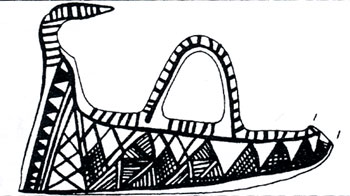 |
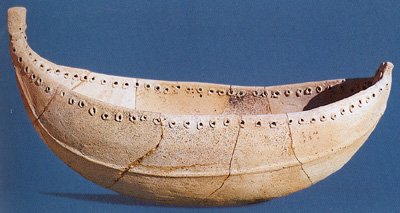 |
Clay model of a boat of Plain White Handmade ware, from Kazaphani Cyprus dated around 1350 BC. The model has holes on either side below the rim and dowel hole for mast. This is one of the largest models of a ship from the Late Bronze Age. Such models become commoner during the Cypro-Archaic period but they begin to appear in Cyprus already in the Middle Bronze Age Late Cypriote I-II period. This model represent more likely a large commercial ship similar to the ship that wrecked at Uluburun. |
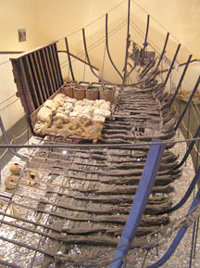 |
The Uluburun wreck is located at Uluburun, which is on the southwestern coast of Turkey near Kas. The wreck is located at a depth of more than 40 meters. The ship has been dated to the Late Bronze Age, with the more specific date of 1300 BC given by dendrochronological testing performed on dunnage or firewood found on the wreck.
The Uluburun wreck has been crucial to the understanding of ship construction and trade in the Late Bronze Age. Pulak describes the wreck as "one of the wealthiest and largest known assemblages of Late Bronze Age trade goods yet discovered in the Mediterranean" . The cargo included nearly a ton of tin ingots and around ten tons of copper ingots from Cyprus. Other cargo finds include elephant and hippopotamus ivory, glass ingots, and bronze tools and weaponry. Interestingly, by examining the personal effects of the ship’s passengers as well as the cargo, archaeologists have hypothesized that there were at least two Mycenaeans aboard, likely men of rank serving as envoys.Some indications of the provenance of the ship and the “nationality” of its crew or merchants on board the ship may be gained from the utility wares (i.e. Cypriot jugs and Mycenaean deep bowls and cook-pots), perhaps also from the incised “trade marks” on the handles of amphora which can be claimed to be connected to the Cypro-Minoan I Script.
These facts, taken with the location of the wreck, point to the coast of Cyprus, as the probable base of the ship, where large naval centres flourished at Enkomi, Kition, the site at Hala Sultan Tekke (Alyke), Palaipaphos and Maa-Palaiokastro or to the south coast of the Argolid, to important centres of naval power, also known from the Catalogue of Ships in the Iliad (*4) and from Hesiod’s Catalogue of Women (*11) to well-fortified Tiryns, Mases, and well-harboured Hermione and Asine
|
| The largest seagoing sailed merchantmen in the Mediterranean and Gulf during the Bronze Age (about 3000-1150 BC) were probably not much larger than the ship that wrecked at Uluburun about 20 tons capacity and 16 meters long. A 13th c. letter from Ugarit, long interpreted as indicative of much larger ships, is reinterpreted in the context of available texts, archaeology, and iconography. Available iconographical evidence points toward a 20 meter maximum length, and the evidence of the Uluburun shipwreck only nominally exceeds the maximum size of seagoing ships appearing in Mesopotamian records. Storage jars from shipwrecks, including those found at Uluburun, are used to address problematical aspects of the textual evidence, wherein the capacity of ships is given in volumetric units. Though problematic, all available evidence suggests that reconstructions of Bronze Age trade networks should assume smaller ship capacities. |
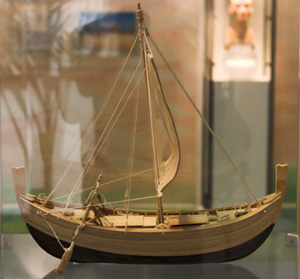 |
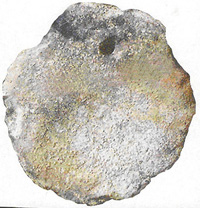 |
The earliest shipwreck so far discovered dated around 2200 BC has been found near the island of Dokos at the entrance of the Argolikos Kolpos gulf. This ship was carring many ceramic objects dated around 2700-2200 BC coming from different areas of Peloponnesian. Very few parts of the ship survived as for instance more than 10.000 pottery fragments and the big anchor which is about 50 cm high and very heavy. |
| Beautiful Aegean stone anchor decorated in the form of an octopus. Even if This element has been also interpreted as a religious ritual stele its identification as a ship anchor, based on general dimensions weight and design, is more reasonable. |
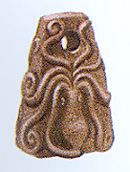 |
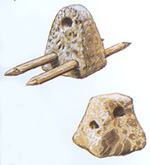 |
Other two stone anchors from the Achaean period. The one at the top had two stakes through it to stop it dragging along the sea bed. |
| This large stone anchor weighing approx. 220 kg. was one of 24 recovered from the Uluburun wreck. All but two of the smallest anchors are of sandstone. The two small limestone anchors found on the wreck, weighing between 21 and 25 kg. These anchors were originally stowed near the bow. |
 |
| Similar Late Bronze Age Cypriote stone anchors have been found at other sites in the Mediterranean like these two specimens respectively from Gulf of Cugnana near Olbia Sardinia and from the shipwreck at Cape Iriain the Gulf of Argos. Though the ethnicity of the ship cannot be determined with certainty, the Cypriote connection of the cargo is undoubted. |
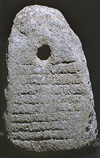 |
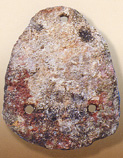 |
| LINEAR B TABLETS/PYLOS ROWERS AND COASTGUARD
|
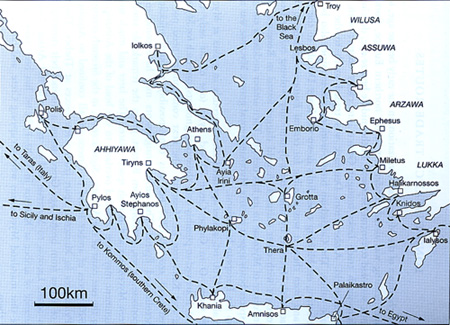
Aegean Trade routes |
Some Linear B tablets from Pylos are referring to naval/military subject-matter (*12). The specific subject of the naval tablets is indicated by the word ",rowers" (e-re-ta) which appears in the first line of three tablets. The first is a list of the numbers of rowers to be provided by various town for an expedition to Pleuron. The second is probably somewhat similar, but the heading is almost all lost, and the numerals are much larger; in all 443 men are recorded. These numbers make it certain that we are not here concerned with a paceful mercantile venture, but a naval operation; and it would be unlikely that the business of trade would be thus organized by a central authority. It is possible that the thirty men specified (PY An12) is the complement of an Achaean ship or part of the complement for a larger ship with fifty oarsmen. The second tablet then appears to allow for at least nine ships. The third tablet is more enigmatic, the heading speaks clearly of "rowers who are absent" (without leave?). |
In these tablets an important coastal town is mentioned Ro-o-wa which provides eight of the thirty men for Pleuron; it is the seat of a coastal command (PY An43). As the Lawagetas and other important people are associated with it here, it may well be the port of Pylos itself. In the linear B the terms na-u-do-o was the ship builders, o-pi-ka-pe-e-we seems related to the superintendants of the hulls or boats, e-re-e-u was the responsible for oarsmen, e-re-ta were the rowers, and ka-ko-na-wi-jo is related to naval bronzes.
The rowers, for the most part, are classified as "settlers" (ki-ti-ta), "new settlers" (me-ta-ki-ti-ta), "immigrants" (po-si-ke-te-re), or by an unidentified term (po-ku-ta). |
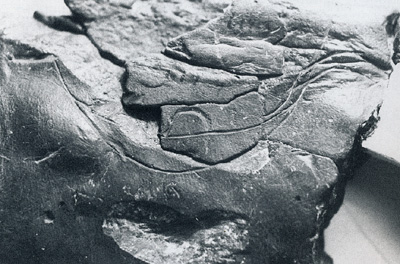 |
On the left image detail of the boat incised on the verso of Linear B tablet PY An 724
On the right image Linear B ideogram of a ship on a fragmentary tablet (KN U 77OO + X 8284 + FR IV-26 + FR VI-0 + FR VII-0) that may record rowers . |
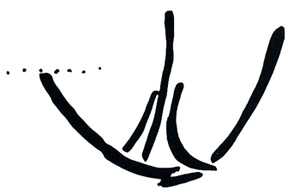 |
| The history of the Aegean ships and Naval trades does not have a concrete point of beginning. Its roots are lost in the depths of centuries of the history of mankind. In a geographical area of which any part is no more than 150 km.away from the sea, the Greeks Aegean areas populations developed from the Prehistoric Age societies which were coastal in their majority. There, they learned to exploit the marine resources and loved the sea. Automatically, the need for protecting and further spreading the cultures that they had developed was created, having as a result the progressive development of the first organised units of the Aegean sea power.
Since the cycladic period several pictorial evidences and shipwreck attested a large development of ships used both as warship and commercialship. These early Aegean ship were characterized by a lean long design and a long vertical prow with symbols mounted on top.
In the Greek mainland ships with the typic curved ram on the prow, are attested since the Middle Helladic period. Because of the intensive commercial trade between the Aegean population and the Near Eastern Kingdoms some of the early Aegean ships show also several similarity in general shape and design with the Egyptian ships of the same period, as well attested in pottery representation and in the famous fresco from Akrotiri in the Thera island dated around 1600 BC. Different type of Minoan ships in size and general design are well represented on several Seals, pottery, fresco and jewellery. Some of The early Achaean ships were similar to Minoan ships, the later design was still characterized by the typic long lean design and a long vertical prow with symbols but with a rams and the platforms located in the stern and in the high stem. the largest of these ships could accomodate up to 50 oarsmen. large sail was also used probably only when the wind was in the right direction. Sea battles represented on Greek pottery dated during the final phase of the Late Helladic periods seem related to these kind of large or medium size Achaean ships which are also attested in pottery/stone depictions, or askoi coming from Anatolian coast settlements and islands.
|
(*0) MICHAEL WEDDE, From Classification to Narrative: The contribution of Iconography towards Writing a History of Early Aegean Shipbuilding; on Mediterranean Historical Review 2008;
MICHAEL WEDDE, Towards a Hermeneutics of Aegean Bronze Age Ship Imagery, Mannheim (1992)
|
(*1) Egypt, the Levant, Anatolia, and Crete all illustrate their ships in this period. Even if the sword-blade inlaid with ship from the mysterious Dorak Treasure contemporary with Troy II should prove genuine, the ship do not look quite Cycladic (Illustrated London News 28 November 1959, 754)
|
(*2)This fresco was clearly painted before the destruction of the island by an earthquake followed by the vulcano's eruption and ashes fallout which based on the most recent analysis seems occurred not later of 1600 BC.
|
(*3) The genuineness of the Ring of Minos has been sometimes questioned and for many years the ring was lost, but in the 2002 it was found and the Greek archaeological authority declared it officially authentic.
|
(*4) Iliad II, 180 and Iliad II, 559-564
|
(*5) PETER CONNOLY; THE LEGEND OF ODYSSEUS, Oxford University Press 1986
|
(*9) MARC HENNIQUIAU, JACQUES MARTIN; LA MARINE ANTIQUE 1, Dargaud Editeur 1997
|
(*10) MICHAEL WEDDE, WAR AT SEA: THE MYCENAEAN AND EARLY IRON AGE OARED GALLEY; Aegaeum n.19
|
(*11) 39, 94.96, b 14-11.
|
(*12) MICHAEL VENTRIS, JOHN CHADWICK; DOCUMENTS IN THE MYCENAEAN GREEK, Cambridge University Press 1956
|
|